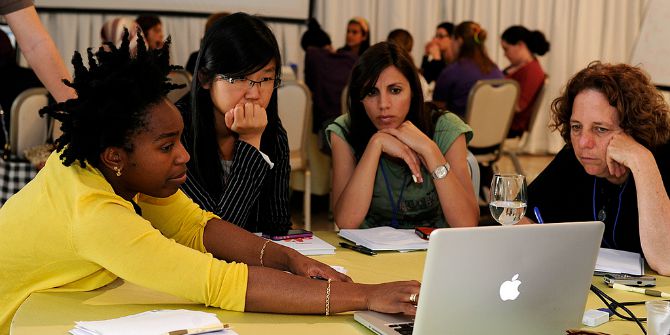As more and more companies adopt inclusion initiatives, the language they use around disability acquires greater importance. How they refer to disabled employees may bring unintended consequences, sometimes increasing marginalisation instead of eliminating it. Jasmine Virhia stresses the importance of listening to how people define themselves. When in doubt, simply ask.
Have you considered how discourse surrounding disability manifests, and how disabled people have faced a history of negative stereotypes, increased marginalisation and internalised negative self-belief perpetuated by language use?
Not everyone will identify with the term disabled. For instance, some people who use British Sign Language identify as part of the Deaf community (note the capitalised ‘D’), where some will refer to themselves as “Deaf and disabled” and the majority reject the term “hearing impaired” as they do not perceive the inability to hear as a deficit.
Many neurodiverse individuals may use the term “neurodiverse” or prefer identity-first language such as “autistic person” or “disabled person.” Dr Louisa Thomas is an autistic researcher at the Centre for Autism (University of Reading), and she encourages leaders to create a language statement. She is an advocate of using identity-first versus person-first language when speaking about autism (i.e., “autistic person” or “on the autistic spectrum” rather than “person with autism”), unless referring to an individual who explicitly states that they have different language preferences. Louisa stated that for her, “use of the word ‘with’ implies that my autism is something that can be taken away […] interestingly, I’m unsure of how to refer to having ADHD, I can’t say I’m an ADHD-er so say ‘my ADHD’.”
There is a wide preference for identity-first language, used to show allegiance and pride in disability or neurodiverse culture (Brueggemann, 2013) much like aspects of identity such as gender, race or sexual orientation (Andrews et al., 2013). But it is important to consider individual preferences as some people find that using the phrase “disabled person” leads people to ignore other identifiable characteristics of someone’s identity (Wright, 1983). Person-first language (such as “person with disabilities”) focuses on someone’s identification as a person prior to their disability, but others suggest that the emphasis on personhood is in itself dehumanising (Sinclair, 2013).
Differences in identification can be based on the variety of disabilities within disability culture and people’s personal experiences (visible and/or non-visible, being born into disability culture or entering later in life; Andrews et al., 2019). An insightful infographic from Bottema-Beutel et al., (2021) (see Figure 1 in the paper) highlights that the way in which we talk and write about disability influences the way people think about disability, thus perpetuating negative stereotypes. For example, strict medical perspectives often use dehumanising language placing disability within a normal/abnormal binary, further implying that “something… needs to be fixed” (Andrews, 2016). In contrast, a social perspective highlights how a distinction must be made between challenges related specifically to disability or neurodiversity, and those due to biased societal attitudes and values.
Many of the terms used to refer to disability also present any difference from a perceived “norm” as a negative, whereas many can be reframed as differences. Refrain from using phrases such as “person suffering from,” “afflicted with” and “physically challenged.” Although terms such as “differently abled,” “special needs,” and “handi-capable” (Hojati, 2012) have been used in the past in attempts to counteract negative associations of disability they are considered euphemisms in disability culture and are not championed by disability advocates. In many instances, references to disability are included when no such reference is necessary. Rather, focus on language relevant to the topic of conversation. An example: “disabled toilet” vs “accessible toilet”, the toilet itself is not disabled and use of the term “accessible” instead highlights the provision of facilities for all.
The following questions have been adapted from Bottema-Beutel (2021) for you to consider when writing or speaking:
- Would I use this language if I were in a conversation with a disabled or neurodiverse person?
- Does my language suggest that disabled and neurodiverse people are inherently inferior to non-disabled and neurotypical people, or assert that they lack something fundamental to being human?
- Does my language suggest that disability and/or neurodiversity is something to be fixed, cured, controlled, or avoided?
- Does my language unnecessarily medicalise disability or neurodiversity when describing reasonable adjustments or educational supports?
- Am I using particular words or phrases solely because it is a tradition, even though disabled and/or neurodiverse people have expressed that such language can be stigmatising?
- Does my language unnecessarily ‘‘other’’ disabled and/or neurodiverse people by suggesting that their characteristics bear no relationships to characteristics of non-disabled or neurotypical people?
Not sure how to refer to someone and/or their disability? Listen to how people define themselves and when in doubt, simply ask how someone would like to be described, refraining from making any assumptions. Self-identification is essential to the formation of a positive disability identity and is resultantly associated with increased self-esteem and well-being (Bogart, 2014; Darling & Heckert, 2010; Nario-Redmond et al., 2013).
♣♣♣
Notes:
- This blog post represents the views of its author(s), not the position of LSE Business Review or the London School of Economics.
- Featured image by Matthew Henry, under a Burst licence
- When you leave a comment, you’re agreeing to our Comment Policy.






Thank you for sharing this. Very helpful to see the difference between identity versus person first languages. Are there any resources about what language that disabled people like to see?
Thank you for reading and your question. I would suggest downloading some of the resources available from the Business Disability Forum: https://businessdisabilityforum.org.uk/knowledge-hub/resources/inclusive-language-the-dos-and-donts/
We at the The Inclusive Initiative will also be working on some Inclusive Language projects so stay up to date with our work and join our mailing list: https://www.lse.ac.uk/tii/secure/tii-mailing-list
Wow, thank you so much for these insights Jasmine.
As someone who is neurodiverse (Aspie), I’m currently researching this area for my Masters dissertation, exploring my organisations Diversity and Inclusion strategy and why it isn’t resonating with neurodiverse employees.
Much of what you have highlighted are things I feel and experience personally but want to gather data and thoughts from others in the organisation. The aim is to provide recommendations around our strategy to make really make it as inclusive and equitable as possible.
Aside from your references in your blog. Is there any other research or authors you would recommend for me to dig deeper? Again, thank you so much for your insights as this is an area I’m passionate about and love the work you are doing.
This blog post is very interesting and makes some important points! As someone who is neurodivergent + given the topic… I thought it was worth mentioning that the way the term “neurodiverse” (instead of “neurodivergent”) is used in relation to “neurotypical” can be viewed as problematic, and so might be something worth considering also 🙂
“When talking about an individual, you’d use the term neurodivergent. Grammatically speaking, diversity is a property of groups, not one person. So on a purely linguistic level to refer to someone as neurodiverse is incorrect.
Of course there’s also a deeper meaning to us pointing this out. We need to be cautious when using ‘neurodiverse’ to describe those who operate out-with the so-called ‘majority’ or ‘mainstream’ of neurotypical people.
Neurodiversity actually refers to the diversity of human minds, the infinite variations of neurocognitive functioning within the human race as a whole. What this means is that technically everyone is neurodiverse so there’s no need to create an us/them type differentiation.
What we need to avoid is ‘Neurodiverse’ being used as another way of saying “you’re different from me, the neurotypical person”. Really it’s meant to mean “we are different from each other”.
It’s really a vehicle that enables us to talk about more focussed terminology. A seemingly subtle yet crucial difference.”
https://www.donaldsons.org.uk/news/the-language-of-neurodiversity